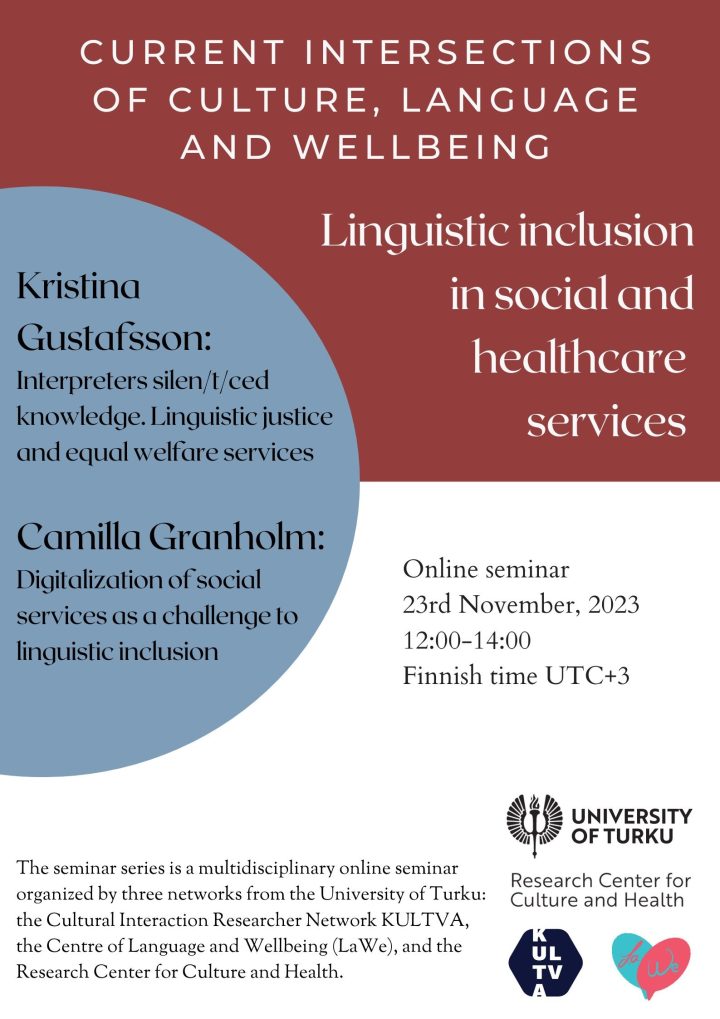Current Intersections of Culture, Language and Wellbeing 23.11.
Kiitelty Current Intersections of Culture, Language and Wellbeing -etäseminaarisarja jatkuu!
Current Intersections of Culture, Language and Wellbeing on monitieteinen etäseminaarisarja, jota järjestää yhteistyössä kolme Turun yliopiston tutkimusverkostoa: LaWe, KULTVA sekä Kulttuurin ja terveyden tutkimusyksikkö. Seminaarisarjan tarkoituksena on laajentaa verkostoja ja tuoda yhteen kansainvälistä tutkimusta sosiaalitieteiden, humanististen tieteiden ja kielitieteiden saralla liittyen terveyteen ja hyvinvointiin. Seminaarisarja jatkuu tuttuun tapaan Zoomissa. Seminaaria on myös mahdollista seurata yhdessä muiden kanssa Turun yliopistolla, Publicumilla (Assistentinkatu 7), huoneessa 399.

The online multidisciplinary seminar series Current Intersections of Culture, Language and Wellbeing continues!
Join us for an exploration of a pressing question in today’s landscape – Linguistic inclusion in social and healthcare services. This third webinar of the series will shed light on two increasingly relevant, but too often hidden, perspectives into social and health services: the nuanced roles and invaluable wisdom of interpreters, and the functions and consequences of digitalization. First, we will hear about the experiences of public service interpreters, and how they could, or perhaps should, be utilized to promote linguistic inclusion in welfare settings. Then we will discuss the challenges of accessibility related to digitalization of social services.
Time: 23.11.2023, 12:00-14:00 (EEST / UTC+03:00)
Place: Zoom
NB! There is also a possibility to follow the seminar together in Publicum (Assistentinkatu 7), seminar room 399 (University of Turku, Finland).
Presentations:
Kristina Gustafsson (Linnaeus University, Sweden): Interpreters silen/t/ced knowledge. Linguistic justice and equal welfare services.
Public service interpreters is a professional group that participates every day in meetings in many different welfare settings. This means that the interpreter becomes a witness to what happens in meetings between welfare professionals and clients who do not share language. The unique position and access to highly variable contexts within the public sector, often taking place behind closed doors, is reinforced by the fact that only they can understand everything said in the conversation. Often, these experiences become silenced because interpreters are not heard or listened to. They are usually not seen as professional partners in inter-professional exchanges and are rarely asked to comment in the media or requested as advisers in public investigations. In this seminar Gustafsson will talk about how interpreters experience and expertise might be used in interprofessional training and what knowledge interpreters can contribute with.
Camilla Granholm (University of Turku, Finland): Digitalization of social services as a challenge to linguistic inclusion.
The contact between service users and the social and welfare system, has become increasingly digital. The purpose of developing digital self-service is to make services more accessible. However, the digitalization of services has, in fact, made it more difficult for many service users to get the benefits and services they are entitled to, since using digital services requires equipment, digital and language skills, a certain level of literacy and a general understanding of the service system in question. Not-native speaking service users, often with migration backgrounds, represent a group that has been negatively affected by the recent developments. Most of the digital social and welfare services are text based and require, for example, adequate skills in reading and writing Finnish, Swedish or English, digital skills and resources and administrative literacy. In the seminar Granholm will share results and insights from a research project studying linguistic diversity and inequality in Finnish social services (SOSKIELI), suggesting that the concept of ‘blended social work’, which refers to a thoughtful integration of face-to-face and online digital services according to the service user’s needs and situation, might be helpful when planning further digitalization of social and welfare services.
